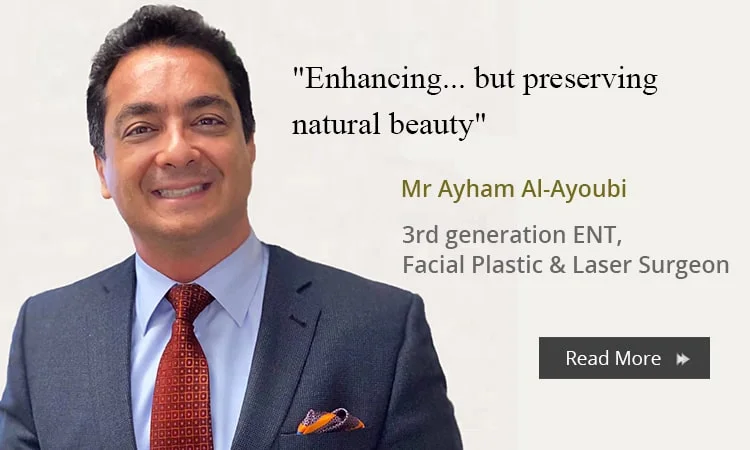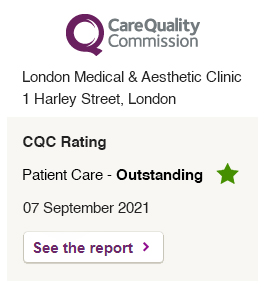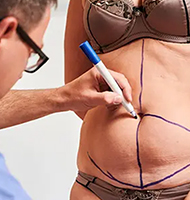We are one of the few London clinics to offer the phenol skin peel which is a highly effective chemical peel with very long lasting results.
Phenol is the strongest and most aggressive deep chemical peel available. This skin resurfacing procedure can be extremely effective at treating signs of severe sun damage, including deep wrinkles, fine lines, sunspots or freckles, and discoloration (Hyperpigmentation), as well as depp acne scars, precancerous growths, and other blemishes.
The procedure diminishes imperfections in sun-damaged, unevenly pigmented or coarsely wrinkled facial areas by peeling away the skin’s top layers.
Because of its strength, a phenol peel should be administered only by an experienced plastic surgeon or dermatologist. This type of deep peel requires a sedative and/or IV anesthesia during the procedure, as well as an anesthetic cream to numb the face.
Recovery is lengthy and uncomfortable, but the treatemnt is highly effective and the results can be dramatic and long-lasting.
Treatment Areas
A phenol skin chemical peel is suitable for patients who suffer from sun-damaged skin, or from pronounced facial wrinkles or blotches and deep acne scars.
The phenol peel technique is also useful for treating crow’s feet lines and crinkly skin around the eyes and the upper and lower lips, for vertical lines and sun damage.
It can be applied solely to the face; the skin on the neck is too delicate to have Phenol peel treatment.
Who can benefit from Phenol peel
A phenol chemical peel is the most drastic of peels. The treatment is usually used for deep wrinkles and acne scars, or for pigmentation changes.
The phenol peel can be used to treat these concerns:
• Age spots and correct uneven skin pigmentations
• Severely sun damaged & weathered skin
• Crow’s feet and under eyes wrinkles
• Smoker’s lines above and below lips
• Deep acne scars
Phenol peels provide an overwhelming improvement in wrinkles. Results are unquestionably superior to those following other peels, especially when combined with CO2 laser, or with dermabrasion.
Patients over 18 with unwanted skin conditions such as wrinkles, acne scars, pigmentation changes, or similar, can benefit from this treatment.
Patients with a tendency to form of keloid (excess scar tissue) or other forms of irregular scar formation are not suited candidates.
The treatment is not suitable for people with a dark complexion. Phenol is a very powerful form of acid, which is often used for peels against medium -deep and deep wrinkles, acne scars, initial stages of cancer, as well as pigmentation changes. The phenol peel is almost only performed in the face.
Phenol has a tendency to remove the skin’s ability to form pigmentation completely. For this reason, the treatment is not suited for people of a dark complexion, and after the surgery, it is often necessary for the patient to protect the treated area against strong sunlight permanently.
How it works
The skin is comprised of three layers: the epidermis, the dermis, and the hypo-dermis for subcutaneous layer. Environmental damage and UV exposure degrades the structure of the skin and affects the epidermis most, and also the Dermal layer.
The phenol peel is a chemical peel that penetrates deeply enough to target the dermis, not just the epidermal layer. This is an advanced option to improve the appearance of deep set static wrinkles, significantly textured skin, and deep atrophic acne scarring.
The Phenol peel works by absorption of phenol, aka carbolic acid and it interacts within the epidermis and dermis to target the damaged tissues, removing them allowing for the skin to heal, repair and regenerate. During the healing process, broken and denatured collageen fibers are removed within the dermis, this provides a stronger, enhanced structure to support the epidermal layer above.
The visible imperfections of the epidermis such as scarring, hyperpigmentation age spots and extensive sun damage are reduced due to the acid removing the outermost layers. This reveals renewed, revitalized, and smoother looking skin.
The doctor begins by thoroughly cleansing the skin ensure it has been fully prepped and anesthetized and then the chemical peel solution is applied.
The phenol acts as its own topical anaesthetic so any discomfort is brief. A phenol skin chemical peel is combined with a lighter chemical peel to the remainder of the face and in most cases, is performed on an outpatient basis.
After the phenol skin chemical peel, the treated area will appear swallen and red. The provider may use a petroleum jelly based solution or a waterproof adhesive tape to soothe and protect the treated area to also encourage cellular proliferation.
It takes new skin cells to form in ten to fifteen days on average days after the peel. This newly revealed skin will be highly sensitized and does not have the ability to tan so, thereafter, must be protected from ultraviolet rays by wearing a recommended Broad Spectrum sunscreen.
How Long does it take?
A full face phenol peel usually takes one or two hours to perform, whilst a treatment on a small area such as around the lip for smoker’s lines may only take 15 minutes. A single treatment is usually sufficient to achieve the desired results.
Patients can to return to the workplace around two weeks post undergoing the chemical peel treatment, though the treated areas remain red for several weeks. This can usually be sufficiently concealed by light make-up coverage.
What to expect
This type of deep peel requires a sedative and/or IV anesthesia during the procedure, as well as an anesthetic cream to numb the face. Recovery is lengthy and uncomfortable, but the treatemnt is highly effective and the results can be dramatic and long-lasting.
With the deep phenol solution, the area to be treated may be coated in petroleum jelly or a waterproof adhesive tape. With the lighter peel, this is not necessary. When undergoing an advanced chemical peel, the patient’s face will be swollen, red, and uncomfortable.
A full face phenol peel usually takes one or two hours to perform, whilst a peel on a small section (e.g. above the upper lip) may only take 10-15 minutes. One treatment is usually adequate.
An epidermal crust will form on the treated skin 3-5 days after treatment. Within a seven to ten day period, this crust will slough off to reveal a layer of brighter, even skin. After a couple of months the skin, which will look very pink at first but it will soon subside to an even skin complexion.
Patients can expect to return to work after two – three weeks of the chemical peel treatment, though the treated areas remain red for several weeks. This can usually be concealed by makeup.
It is important to note deep level chemical peels are not without any side effects. Most side effects can be significantly reduced and minimized by following the stringent pre-post care protocol that the practitioner provides. This includes avoiding Ultraviolet exposure for a prolonged period of time after the peel, and refraining from picking, scratching or pulling at the skin whilst it’s flaking, crusting and going through it’s regenerative phase.
Phenol peel FAQS
What are the pros and cons of a Phenol peel?
A phenol chemical peel can improve the quality of the damaged skin in just a single treatment, yielding dramatic results. The patient can expect results to last as long as 8- 10 years.
Phenol is absorbed through the skin during the treatment and can cause stress to the heart, kidneys, and liver. If the patient has heart problems or a medical history with other serious issues, they cant have phenol chemical pell treatment.
This peel can have a significant bleaching effect in the treated area, so it’s not suited for people with dark skin tones (only those with a Fitzpatrick skin type of I-III).
The recovery period after this deep chemical peel is painful, difficult, and long. the petiant needs to take strong pain medication and won’t want to go out in public for the first two weeks of the healing process.
Side effects include peeling, crusting, and discomfort for up to six weeks, and redness for up to three – six months.
What happens during a Phenol peel procedure?
First, The patient will be given a sedative or IV anesthesia as well as a topical anesthetic cream, to fully numb the face and keep the patient relaxed.
After thoroughly cleansing the skin, the doctor will apply the phenol solution to the face in cycles, for as long as 90 minutes. The face should be numb, but the patient may still feel tingling or burning as the peel removes the epidermis, the skin’s top layer.
After the last cycle is complete, the doctor will neutralize the chemical solution with water and cover the face with a petroleum-based ointment and a tape mask that will be removed the following day. This protects the skin as the new top layer develops.
How long does Phenol peel recovery take?
Most people need two – threee full weeks of downtime after a phenol peel treatment.
Immediately after the treatment, the patient will look like he have a severe sunburn. The doctor will provide a prescription for pain medication, since the face will very swell and throb. It will then ooze, scab over, and peel, eventually revealing the new skin underneath.
For the first week, the patient will have to keep the face moist by frequently applying wet gauze pads and an ointment like Vaseline or Aquaphor. The skin will be extremely sensitive, and the patient will be given strict skincare instructions including protecting the skin from the sun every day with a high-SPF sunscreen.
Most people can return to their normal activities about two weeks after a phenol peel, and patient can start applying makeup at that point. The sunburned look should fade at about three months post-treatment, when patient starts to see the final results.
What makes phenol chemical skin peel different?
Phenol peel is different from other average chemical peels in that this is the deepest chemical peel available. This type of treatment works very well for fair skinned individuals. Another advantage is that phenol peel effects last longer than the regular peel. Results are dramatic, and most patients are very pleased.
Are phenol peels dangerous?
When administered by an experienced plastic surgeon or dermatologist and for the right candidate (someone with a fair skin tone, a low risk of hyperpigmentation, and no underlying medical issues), phenol peel treatments can be safe.
However, phenol peels have fallen out of favor in recent years, as more providers and patients opt instead for a series of light and medium-depth skin peels, such as glycolic acid peels. These can often achieve similar results with less risk and a shorter recovery time.
Is a phenol peel worth it?
As one of the most effective treatments for acne, a phenol peel goes deep into the skin to cause significant exfoliation to help correct the appearance of acne scarring, sun damage, wrinkles, and skin discoloration. A phenol peel basically uncovers healthy skin and achieves fantastic results.
How painful is a phenol peel?
A phenol peel treatment usually takes about one to three hours to complete. After the patient is sedated, the chemical solution will be carefully applied onto the skin. The patient may experience a mild burning or tingling sensation during the primary application of the of the chemical solution to the face.
How often can the patient get a phenol peel?
It also causes more collagen production, and these two effects have a profound effect on wrinkles. The effects of phenol peel are cumulative. Repeated sessions, spaced out between months, are recommended for optimal results.
How long does the face stay red after a phenol peel?
Depending on the depth of the peel, most patients experience redness for anywhere from 4-6 weeks after the procedure. Makeup can be used to cover some of this up about 3 weeks after the peel. After the redness is resolved, the skin will look refreshed.
Is phenol in chemical peel safe?
The chemical used in a deep chemical peel, phenol, can lighten the skin that’s treated. With this kind of peel, the new skin often loses its ability tan normally. It is critical that the treated area is protected from the sun. Phenol (a deep peel agent) also can pose a special risk for people with heart disease.
What’s better chemical peel or microneedling ?
Chemical peels generally work best on superficial imperfections; conversely, microneedling penetrates deeper to improve more troublesome issues. Many people with wrinkles, deep acne scars find a combination of microneedling and chemical peels and CO2 laser deliver the best results.
What is more effective phenol chemical peel or CO2 laser ?
CO2 laser generally delivers faster results than peels, with results showing in just three to five days. This is especially true when patients choose laser resurfacing to fade acne scars.
What is a phenol peel made of?
The phenol peel is the chemical peel that goes deep enough to improve the dermis, not just the epidermis. The skin is made up of three layers: the epidermis, the dermis, and the hypodermis. The damage the environment and sun do to our skin affects the epidermis most, then portions of the dermis.
How long does it take for a deep chemical peel to heal?
After four to six days, most of the peeling should be complete, but it may take anywhere from ten to fifteen days before the new skin has developed. Within fourteen to twenty days, the skin should be completely healed.
What does the face look like after a chemical peel?
First few days the patient will notice some dryness, irritation, and mild swelling. Two to Three days the skin may look flaky or peel, and discolorations or imperfections may temporarily be more noticeable. Three to four days the skin may breakout or notice skin looks tan or slightly darker than usual.
When I can use hyaluronic acid after A chemical peel?
The use of a gentle cleanser and a hydrating serum or gel, like one that contains hyaluronic acid or ceramides to help soothe the skin in the days following a chemical peel is highly recommended.















































